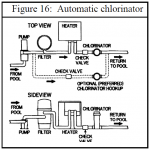Hey all, I'm thinking about adding a Hayward H150FDN gas heater. I'm looking at the plumbing diagram in the Hayward manual (page 26, copied below) for installing a chlorinator (SWG in this case) after the heater. I'm 100% good with the solid-line part of this diagram but I don't understand the "optional (preferred)" hookup. It says "preferred" but it's not discussed anywhere in the text.
It looks like this runs the chlorinator on a separate loop that bypasses the heater. This doesn't make sense to me though. It tees off after the pump but before the filter. This means the pump will be pushing unfiltered/unheated water back into the pool. I imagine the resistance on this path will be much lower so you might not get much flow through the filter/heater at all.
What am I missing, and why is this "preferred" anyway? Can I just ignore the dotted-line part and do it the other way?
Also I'll tack on a related question: the heater inlet/outlet are sized for 2" or 2 1/2" pipe, but all of my existing lines are 1 1/2". Is it ok to just reduce from 2" to 1 1/2" at the heater nipples? Do you recommend buffering with any length of 2" pipe before/after the heater?

It looks like this runs the chlorinator on a separate loop that bypasses the heater. This doesn't make sense to me though. It tees off after the pump but before the filter. This means the pump will be pushing unfiltered/unheated water back into the pool. I imagine the resistance on this path will be much lower so you might not get much flow through the filter/heater at all.
What am I missing, and why is this "preferred" anyway? Can I just ignore the dotted-line part and do it the other way?
Also I'll tack on a related question: the heater inlet/outlet are sized for 2" or 2 1/2" pipe, but all of my existing lines are 1 1/2". Is it ok to just reduce from 2" to 1 1/2" at the heater nipples? Do you recommend buffering with any length of 2" pipe before/after the heater?


